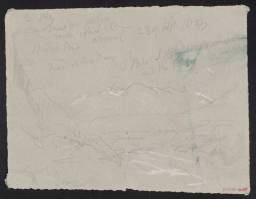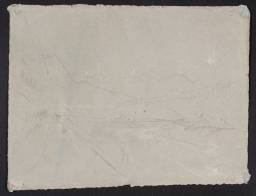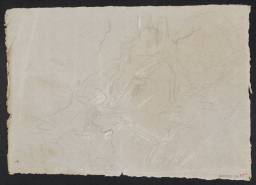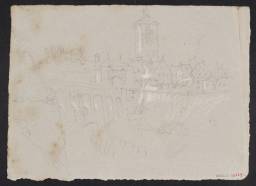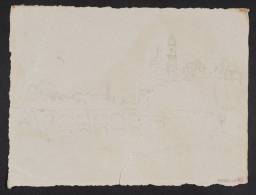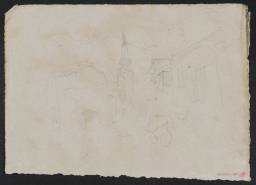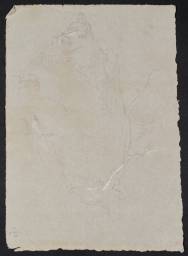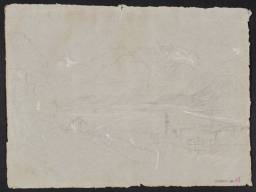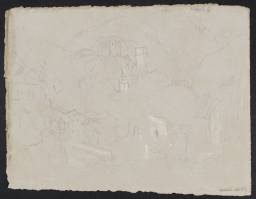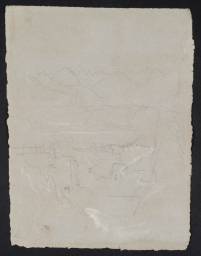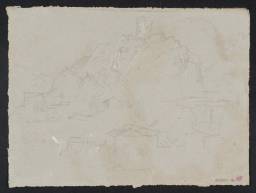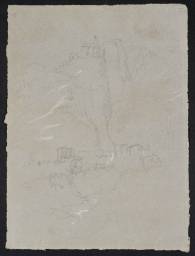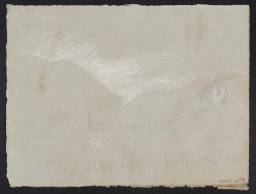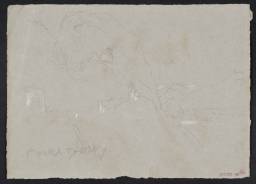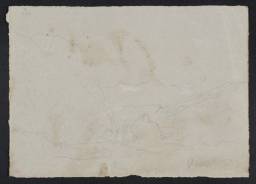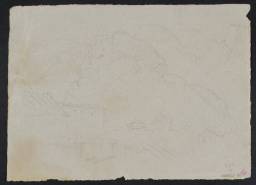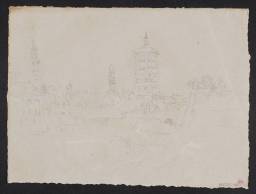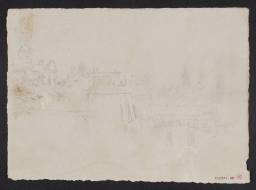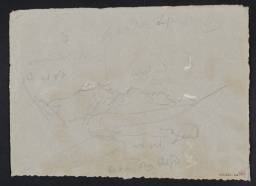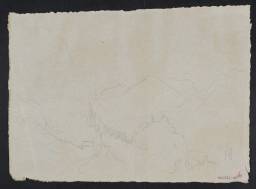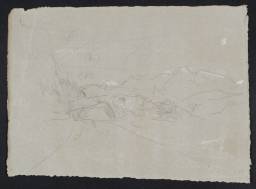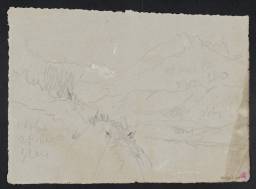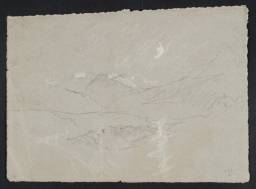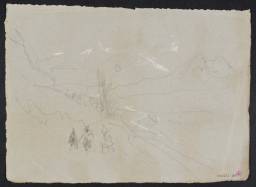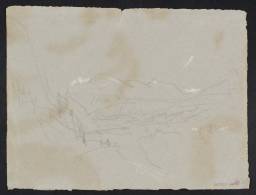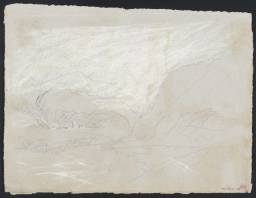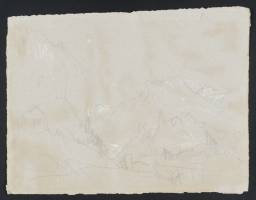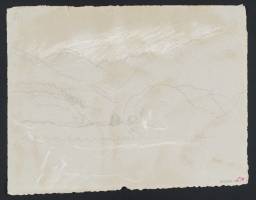Turner Bequest CCCXLI 18, 18v, 115, 129, 147, 155–170v
References
This subsection comprises twenty pieces of grey paper, which Turner had carried with him from England, only apparently resorting to them towards the end of the long 1833 tour. They were used for pencil sketches, often with white chalk highlights, in two distinct groups of mountain and urban subjects. The circumstances of the first batch (D33696–D33697, D33796, D33840–D33852, D33855–D33857, D33859–D33866, D40329; CCCXLI 18, 18v, 115, 155–161v, 164–170v) have been summarised by Cecilia Powell:
By the time that Turner reached Innsbruck on 23 September he had started making pencil sketches on small loose sheets of torn grey paper as well as in his sketchbook ... The Turner Bequest contains over 500 such pieces of grey paper [mostly, as here, in section CCCXLI] and, although one group of sixteen can be reassembled into its original sheet and contains the scribbled date ‘23 of Sep. 1833’, other pieces or groups bear depictions of entirely different regions from that visited in 1833 and can be assigned to several other, identifiable tours of the 1830s and 1840s.1
There are scattered views of Innsbruck, in the Austrian Alps, in the Venice up to Trento sketchbook (see under Tate D31629; Turner Bequest CCCXII 17). In the 26 September issue of the local Intelligenz-Blatt,2 Turner was noted as having arrived there three days previously. He had been using that book since Venice, through various ranges of the Alps including the Dolomites, and it ended up almost full, with some town and city views but also many mountainous scenes in the valleys of the Brenta, Adige (Etsch) and Isarco (Eisack). It is unclear when he began using the present sheets, but it may have been in the course of quite a brief period around 23 September; the date is (most unusually) written in full on D33696 (CCCXLI 18), as ‘23 of Sep 1833’.
Turner’s own notes in the Venice up to Trento book indicate that he had been at Bolzano (Bozen), roughly seventy miles south via the Brenner Pass, on 22 September. Following possible views of Bressanone (Brixen; Tate D31719; Turner Bequest CCCXII 62a) and the Forte di Fortezza (Franzensfeste; D31710; CCCCXII 57a), there are no identified subjects after Vipiteno (Sterzing; D31662; CCCXII 33a), a few miles south of the pass, until just short of Innsbruck. The Brenner or its vicinity may be indicated in an inscription on D31754 (CCCXII 81).
The sixteen relevant sheets were used for twenty-eight sketches (albeit D40329, the verso of CCCXLI 115, is very slight), with all but four sheets featuring drawings on both sides. There is no obvious sign of pencil work carried over from one to another, perhaps indicating that the pieces had already been neatly separated in Turner’s usual fashion (see the technical notes below). Most depict broad Alpine valleys, with occasional distant spires or scattered buildings.
D33796, D33843, D33845, D33848 and D33851 (CCCXLI 115, 157, 158, 159v, 161), show aspects of Burg Fragenstein, just to the north-west of Zirl, a small town about seven miles up the Inn Valley west of Innsbruck. D33840 (CCCXLI 155) is a street view with a Baroque church spire, again probably in Zirl, while D33842 (CCCXLI 156) is an elevated prospect over the town and river. D33847 (CCCXLI 159) may show Turner’s approach along the valley at sunset.
The most distinctive subject is the small Baroque Kalvarienberg church, on a steep crag north-east of the town and east of the castle, drawn three times with the sheets turned vertically, on D33841, D33846 and D33852 (CCCXLI 155v, 158v, 161v). See also D33849–D33850 and D33856 (CCCXLI 160, 160v, 165), with views from there along the valley below the precipitous Martinswand. There are also several unidentified valley subjects with extensive notes on colour and light effects around moonrise; see under D33697 (CCCXLI 18v).
The other four drawings included in this grouping (D33881, D33832, D33853–D33854; CCCXLI 129, 147, 162, 163) are here identified as showing the outskirts of Augsburg in Bavaria, over 120 miles north-north-east of Zirl by the Füssen road,3 where Turner also drew within the city on remaining pages of the Venice up to Trento book (see under Tate D31655; Turner Bequest CCCXII 30). They all appear to feature the lost Göggingertor gate tower, which stood above a bridge over the old moat west of the city centre. Augsburg is the last identified Venice up to Trento subject; the artist likely acquired the Rotterdam and Rhine sketchbook there, which lasted him for the rest of the tour. He used it first for more studies in and around the city (Tate D32543–D32554; Turner Bequest CCCXXII 2a–8), including various other towers along the moat.
Although Turner had also passed through Augsburg on the outward leg, making a handful of drawings in the Heidelberg up to Salzburg sketchbook (see under Tate D29930; Turner Bequest CCXCVIII 59), it is perhaps likely the present sketches followed on immediately from those of the Alps. Their torn edges all match up to form a grid, suggesting that up to twelve further pieces could originally have been prepared from the same sheet, although these have yet to be recognised if they survive (see the technical notes).
Albeit without specifying which, Andrew Wilton has remarked that a ‘large number’ of such sheets were used in 1833.4 Turner used such paper again for pencil, watercolour and gouache studies in the course of his final trip to Venice, as detailed in the present author’s Introduction to the 1840 tour. Other drawings on grey paper which might potentially be linked with 1833 have been placed in provisional ‘Italy c.1828–43’ and ‘Northern Italy or Switzerland c.1828–44’ sections. As discussed under the 1833 Venice sketchbook (Tate; Turner Bequest CCCXIV), six colour studies of the city on grey paper (Tate D32205–D32210; Turner Bequest CCCXVII 20–25) may possibly date from either 1833 or 1840; albeit with reservations, in the present catalogue they have been placed at 1840 with the many other watercolours on white, grey and brown papers now accepted as belonging to that tour.
It has also been suggested that a handful of nude studies on irregular grey sheets (Tate D33939–D33941, D33969; Turner Bequest CCCXLI 228, 229, 230, 254) were drawn in the course of the 1833 tour; see the ‘Nude Studies and Erotica c.1830–40’ section of this catalogue.
Technical notes
How to cite
Matthew Imms, ‘Zirl and the Alps near Innsbruck; Augsburg 1833’, subset, May 2019, in David Blayney Brown (ed.), J.M.W. Turner: Sketchbooks, Drawings and Watercolours, Tate Research Publication, April 2023, https://www

